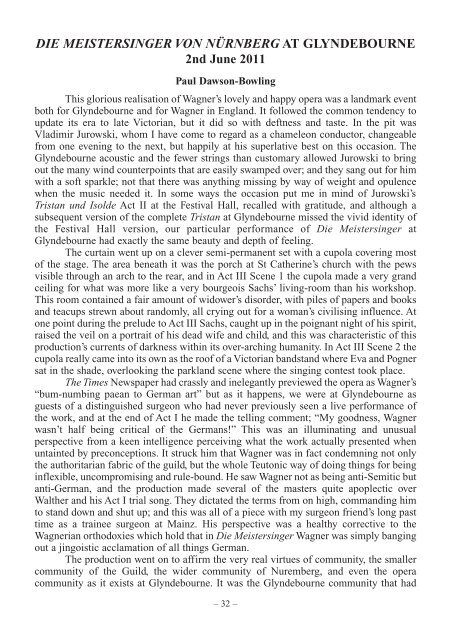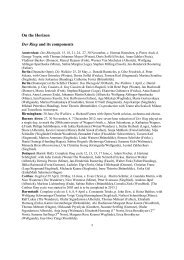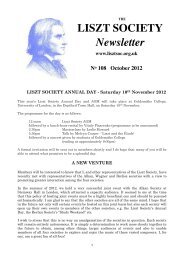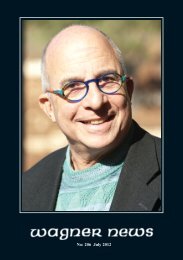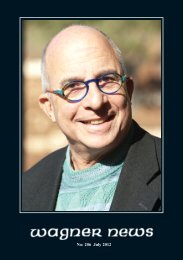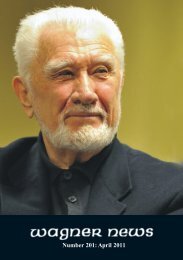Number 202: July 2011 - Wagner Society of England
Number 202: July 2011 - Wagner Society of England
Number 202: July 2011 - Wagner Society of England
Create successful ePaper yourself
Turn your PDF publications into a flip-book with our unique Google optimized e-Paper software.
DIE MEISTERSINGER VON NÜRNBERG AT GLYNDEBOURNE<br />
2nd June <strong>2011</strong><br />
Paul Dawson-Bowling<br />
This glorious realisation <strong>of</strong> <strong>Wagner</strong>’s lovely and happy opera was a landmark event<br />
both for Glyndebourne and for <strong>Wagner</strong> in <strong>England</strong>. It followed the common tendency to<br />
update its era to late Victorian, but it did so with deftness and taste. In the pit was<br />
Vladimir Jurowski, whom I have come to regard as a chameleon conductor, changeable<br />
from one evening to the next, but happily at his superlative best on this occasion. The<br />
Glyndebourne acoustic and the fewer strings than customary allowed Jurowski to bring<br />
out the many wind counterpoints that are easily swamped over; and they sang out for him<br />
with a s<strong>of</strong>t sparkle; not that there was anything missing by way <strong>of</strong> weight and opulence<br />
when the music needed it. In some ways the occasion put me in mind <strong>of</strong> Jurowski’s<br />
Tristan und Isolde Act II at the Festival Hall, recalled with gratitude, and although a<br />
subsequent version <strong>of</strong> the complete Tristan at Glyndebourne missed the vivid identity <strong>of</strong><br />
the Festival Hall version, our particular performance <strong>of</strong> Die Meistersinger at<br />
Glyndebourne had exactly the same beauty and depth <strong>of</strong> feeling.<br />
The curtain went up on a clever semi-permanent set with a cupola covering most<br />
<strong>of</strong> the stage. The area beneath it was the porch at St Catherine’s church with the pews<br />
visible through an arch to the rear, and in Act III Scene 1 the cupola made a very grand<br />
ceiling for what was more like a very bourgeois Sachs’ living-room than his workshop.<br />
This room contained a fair amount <strong>of</strong> widower’s disorder, with piles <strong>of</strong> papers and books<br />
and teacups strewn about randomly, all crying out for a woman’s civilising influence. At<br />
one point during the prelude to Act III Sachs, caught up in the poignant night <strong>of</strong> his spirit,<br />
raised the veil on a portrait <strong>of</strong> his dead wife and child, and this was characteristic <strong>of</strong> this<br />
production’s currents <strong>of</strong> darkness within its over-arching humanity. In Act III Scene 2 the<br />
cupola really came into its own as the ro<strong>of</strong> <strong>of</strong> a Victorian bandstand where Eva and Pogner<br />
sat in the shade, overlooking the parkland scene where the singing contest took place.<br />
The Times Newspaper had crassly and inelegantly previewed the opera as <strong>Wagner</strong>’s<br />
“bum-numbing paean to German art” but as it happens, we were at Glyndebourne as<br />
guests <strong>of</strong> a distinguished surgeon who had never previously seen a live performance <strong>of</strong><br />
the work, and at the end <strong>of</strong> Act I he made the telling comment; “My goodness, <strong>Wagner</strong><br />
wasn’t half being critical <strong>of</strong> the Germans!” This was an illuminating and unusual<br />
perspective from a keen intelligence perceiving what the work actually presented when<br />
untainted by preconceptions. It struck him that <strong>Wagner</strong> was in fact condemning not only<br />
the authoritarian fabric <strong>of</strong> the guild, but the whole Teutonic way <strong>of</strong> doing things for being<br />
inflexible, uncompromising and rule-bound. He saw <strong>Wagner</strong> not as being anti-Semitic but<br />
anti-German, and the production made several <strong>of</strong> the masters quite apoplectic over<br />
Walther and his Act I trial song. They dictated the terms from on high, commanding him<br />
to stand down and shut up; and this was all <strong>of</strong> a piece with my surgeon friend’s long past<br />
time as a trainee surgeon at Mainz. His perspective was a healthy corrective to the<br />
<strong>Wagner</strong>ian orthodoxies which hold that in Die Meistersinger <strong>Wagner</strong> was simply banging<br />
out a jingoistic acclamation <strong>of</strong> all things German.<br />
The production went on to affirm the very real virtues <strong>of</strong> community, the smaller<br />
community <strong>of</strong> the Guild, the wider community <strong>of</strong> Nuremberg, and even the opera<br />
community as it exists at Glyndebourne. It was the Glyndebourne community that had<br />
– 32 –


